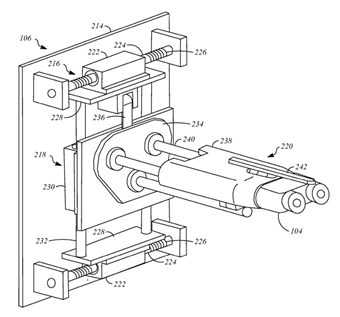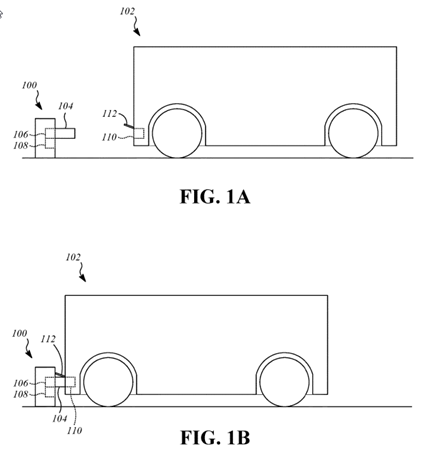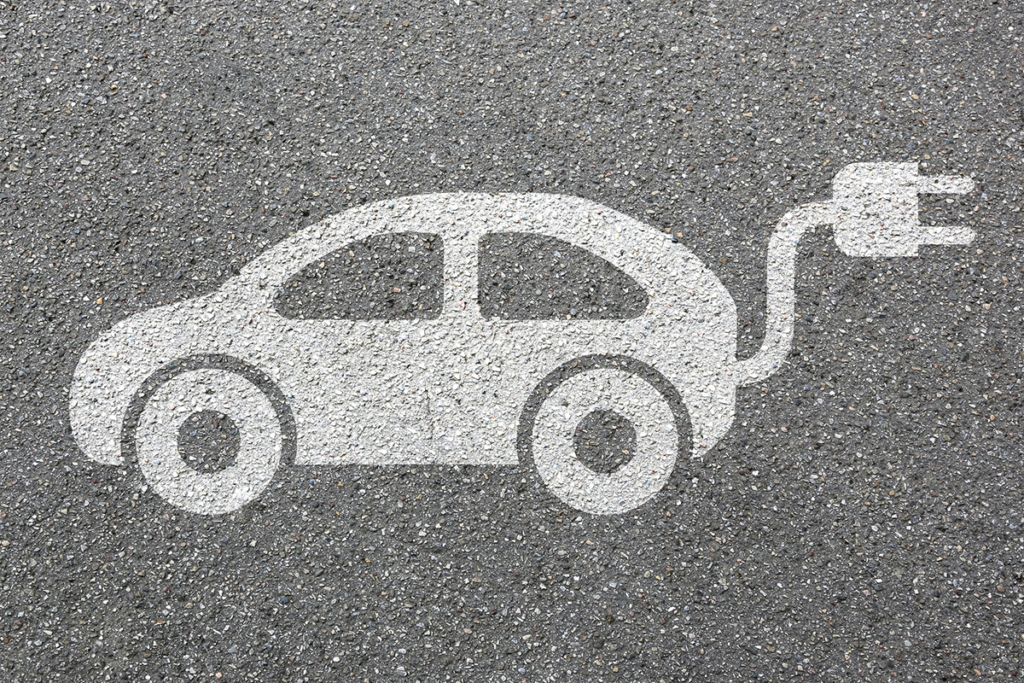Recently issued Apple patent utilizing passive alignment technology for charging an electric car that does not require human initiation illustrates a possible solution to one of the many hurdles facing electric cars going mainstream.
 Filed on May 18th of 2020, granted less than five months later, and titled “Charging station with passive alignment mechanism,”[i] Apple’s patent discloses a first connection or plug that can be attached to sliding rods on the charging station that allows for its position to change, both vertically and horizontally, depending on the location of the corresponding receiver connection port on the electric car. The first connection protruding from the charging station can also be magnetically attracted to the receiving connection in the electric car and guided into the receiving port to charge. This new patent paves the way for passive alignment charging technology for electric vehicles.
Filed on May 18th of 2020, granted less than five months later, and titled “Charging station with passive alignment mechanism,”[i] Apple’s patent discloses a first connection or plug that can be attached to sliding rods on the charging station that allows for its position to change, both vertically and horizontally, depending on the location of the corresponding receiver connection port on the electric car. The first connection protruding from the charging station can also be magnetically attracted to the receiving connection in the electric car and guided into the receiving port to charge. This new patent paves the way for passive alignment charging technology for electric vehicles.
Electric cars generally do not have the battery capacity to operate for too long without being recharged. Unlike conventional vehicles powered by fossil fuels, electric cars lack a readily available power source sitting in a tank in the vehicle itself, capable of generating power on demand. Many owners find the ideal time to charge their vehicle to be overnight while sleeping.
But suppose the electric car owner forgets to engage the charging station before turning in for the night. The owner could wake to a vehicle without enough charge in its battery for the morning commute. One potential solution to this problem is to have the vehicle connect to the charging station as it is being parked, no longer requiring the owner to initiate the charging process.
Taken from Apple’s patent and illustrated by the two figures below, the idea is to initiate a charging process by simply driving the car into a parking space and parking the car.
The owner pulls the vehicle into a parking spot at home, and the plug repositions itself along the attached rods to align itself so that it can connect with the receiver port on the electric car. The owner no longer has to even think about charging the vehicle because the charging is initiated automatically.
In addition to realigning the protruding connector, the patent also discloses the possibility of funneling the plug into the receiver port and even pivoting the plug itself, altering the angle to facilitate a proper connection further. The idea is that even if the parking of the vehicle is not perfect, the charging station could adjust the plug to make the connection proper. Once connected, magnetic attraction is used to secure the connection, similar to its other magnetic charging connections used in some Apple technology and products.
Once considered an oddity, electric vehicle charging stations are becoming more plentiful, appearing in a wide range of locations, from mall parking lots to grocery stores parking lots. Their growing presence is especially noticeable in large, metropolitan areas. However, electric car owners are still most often relying on their own charging station at home to power their cars, having the car charge overnight while the owner sleeps.
While the proposed disclosure does not solve all the issues that electric vehicles may have, the charging station with passive alignment mechanism patent presents one potential and exciting solution to one of the issues impeding the widespread adoption of electric vehicles. It is exciting to see what ideas and solutions may come from this.
For an initial consultation regarding your ideas, please do not hesitate to call 972-367-2001 or email tuck@ caglaw.com. More information and articles can be found by visiting the Carstens, Allen & Gourley, LLP website at caglaw.com.
___________
[i] U. S. Patent No. 10,804,485
___________________________________________________
James Tuck is an associate at Carstens, Allen & Gourley, LLP. His practice of intellectual property includes the preparation and prosecution of patent and trademark applications and the litigation of intellectual property rights.


